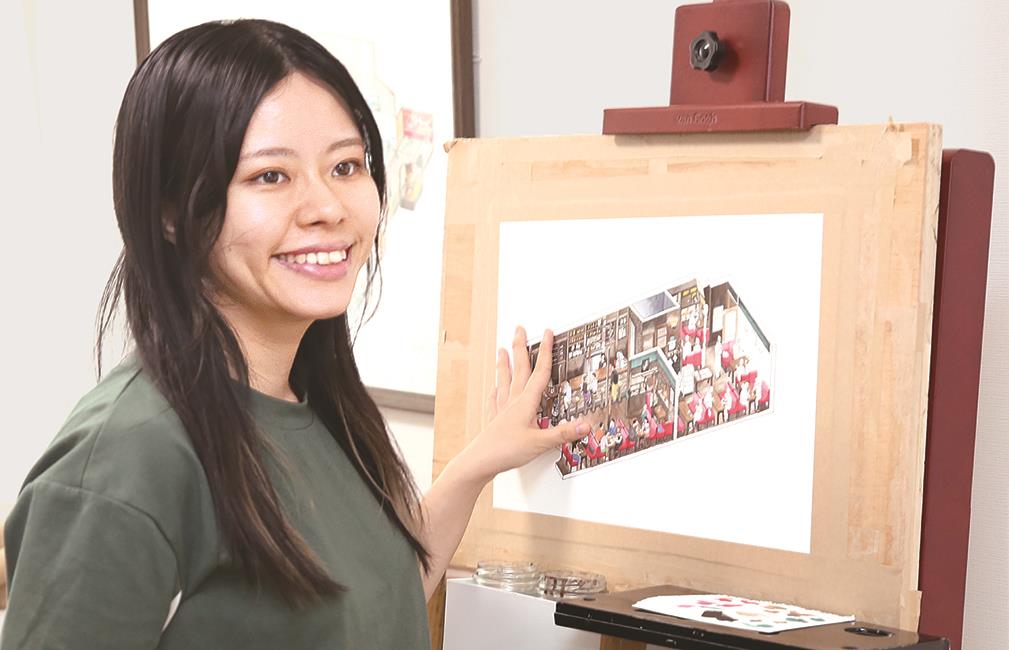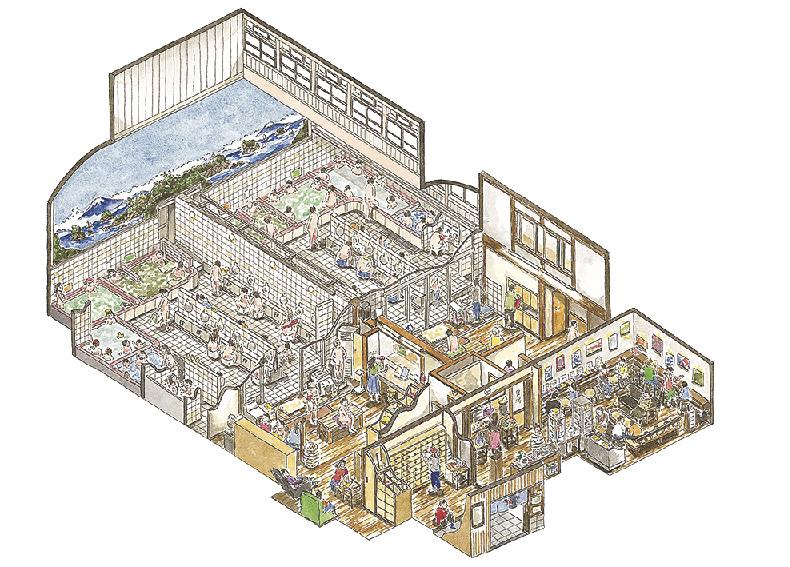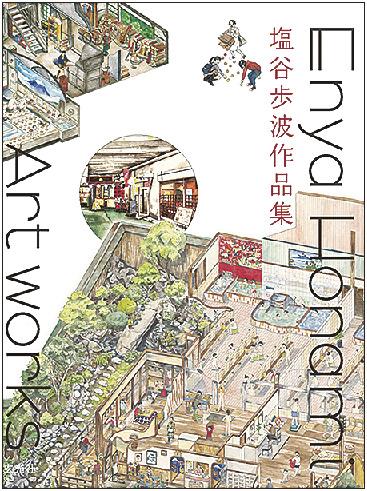What kind of work suits you and what makes you happy? Ayuunami Shioya, a freelance artist, has an unconventional career, having studied architecture as a student, found work at a design office, and after taking a leave of absence, became the manager and illustrator of Kosugiyu in Koenji, Tokyo. “The value lies only in continuous failure,” says Shioya, looking back on his career so far. He discusses his thoughts on his work and working style.

Afunami Shioya
My love of painting grew through visiting art museums where I often went with my family. During my college years, I studied architecture and got a job at a design firm. While working at a design office, I loved the time building friendships with clients and working together to build new buildings.

Illustration by Kosugiyu. Conveying the atmosphere of a public bath through detailed illustrations (courtesy of Ayuha Shioya)
On the other hand, I also felt that the company was not suitable for me. There were many meetings needed before an idea was approved and decision making took time. As a young employee, I was not easily delegated what I wanted to do, I had to do a lot of chores, which made me feel uncomfortable with the vertical society.

“Shioya Afunami Collection” Genkosha, 2,750 yen (tax included)
Even though I can't continue to be an entrepreneur, sometimes I wish I could continue to work in architecture. There are so many talented people in the architectural world and working in that environment is a great learning experience and I think you learn a lot of skills.
I started going to the bathhouse regularly when I was on leave from my design office. The bathhouse was a place of rest and relaxation, with enough distance for me to feel connected to people, like the conversations I had with an old lady whose name I didn't even know.
I decided to try to depict the space of such a public bathhouse and the people inside it in three dimensions using isometric drawing. In the published illustration collection ``Sento Illustrated', he depicted not only the building but also the people inside, as if looking at the entire space from above, conveying the charm of public bathhouses.
This way of drawing was strongly influenced by the teachings of my university teacher Masayuki Irie, ``A building without people will die.'' Sometimes we actually stayed at the site and studied the building. I also consciously depicted the use of space in an understandable way through people's positions, behaviors, facial expressions, etc.
Then Mr. Kosugiyu came to see me and I was promoted to the position of chief clerk. As a manager, I had many opportunities to talk to people of all ages that I had never had the chance to meet before. What made me especially happy was that I could feel a strong connection with people through interactions with the old men and women who always greeted me at the counter. I think this has to do with what I liked and thought I was suitable for when I worked at a design office.
To find a place where you feel comfortable, including work, I think it is important to go to many places, make many mistakes, and repeat the process of trial and error. I don't think you will realize the value of a place, a person, or an environment unless you experience failure. I believe that it is better to fail as much as possible, and I believe that what we achieve after many failures is very precious and valuable.
What I value in my work is humility. When I was in my 30s, I published Sento Illustrated, appeared on TV, and became a freelancer. I never imagined myself living this way, so there were times when things didn’t go well not only in my work but also in my personal life. When I discussed this with a friend, she said, “Aren’t you being a little arrogant?” Those words made me reflect on how I used to think I could do everything myself and how I unconsciously looked down on others.
I realized that there were many things I couldn't do. After that, I felt much better. I think by changing my values and way of thinking, and trying to be more flexible, things turned out in a positive way.
When I encounter a problem, I usually don't try to solve it alone. There were times when I solved the problem by consulting with friends and talking about various things. Sometimes I couldn't solve the problem and ran away. If you keep it all to yourself and make a decision without consulting anyone, it will put a huge burden on your mind and cause difficulties later. There are many ways to solve any problem and there is no way you can solve it alone even if you don't have experience. I think it's better to hear opinions from many people so that you can think about it from many angles.
I want to say to people who are worried about changing jobs or quitting that there is another way out. I think I just wasn't a good fit for the company itself. I'm sure there are many people who feel that way, and it's also possible that the company and the person weren't a good fit. That doesn't necessarily mean there's something wrong with you.
When I took time off work, I tended to think it was my fault. If you feel guilty about taking time off, or if you feel like you are a failure as a member of society because you can’t do the job you are asked to do, your perspective becomes extremely narrow. Personally, I have had a more enjoyable life since changing jobs, and I hope people who are worried about taking time off don’t blame themselves too much.
The important thing when making a decision is to think it through. When I'm on leave, I try not to worry about it. When people worry, I think it's better to think it through and get on track, and the answers that come to you after worrying will be more important.
I want to draw more buildings in the future. I would like to continue the series ``○○ Illustrations'', similar to published works such as ``Sento Illustrated'' and ``Jun Kissa Illustrated''. I recently realized that writing down things I don't want to lose is the source of my desire to create. In addition to old buildings such as temples, small cinemas and variety theaters in rural areas, and public bathhouses such as city-run buildings, I also want to draw buildings from overseas and buildings that someone wants to preserve. Even if a building has disappeared, I can still draw it if there are photos and drawings, so I want to take on the challenge of restoring that space in my work.
Besides painting, I also have a dream of owning my own studio and I want it to be not only a working space but also a place where people can gather, like a cafe. I have loved going to museums with my family since I was a child, so I would be happy if one of my paintings could be displayed in a museum.
When I first started drawing, I always found it tedious, but once I started, it became fun and I felt motivated. My favorite part of the creative process was coloring. It felt great knowing that I was creating something beautiful with my own hands. I think it was these wonderful moments that kept me going even when things got tough.
(Enya Honami) Born in Tokyo. Completed graduate school of Waseda University (majoring in architecture). After working at a design office, he became manager and illustrator of Kosugiyu. Currently working as a freelance artist. My hobbies include reading, tea ceremony, and cooking. ``Collection of Shioya Afunami'' (Genkosha) was published on August 27.
Invite partners to watch the activities of Pacific Group Co., Ltd.
FanPage: https://www.facebook.com/Pacific-Group
YouTube: https://www.youtube.com/@PacificGroupCoLt






